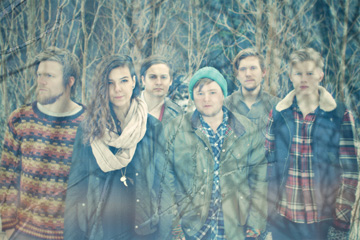Spotlight: Of Monsters and Men

Photo by Anthony Bacigalupo
Separately, the six members of alternative folk band Of Monsters and Men are distinct individuals: a sweet-voiced female lead; a charming, burly co-lead with soft eyes and a full beard; a light-haired, clean cut guitarist; a powerful drummer with lumberjack characteristics; a pianist who prefers jazz and classical music; and a bassist, formerly of one of the biggest underground metal bands in Iceland. Together, the group coexists to produce surround sound folk-pop that has caught the ear of many, culminating in their first U.S. tour with 13 sold-out shows.
“We’re kind of like fishermen,” guitarist Brynjar Leifsson says of their schedule. They’re out on the road for a month, back home to Iceland for six days and then, back out on the road. Surrounded, at the moment, by an American feast of hot dogs and hamburgers, he shifts in his cramped seat on their sleek tour bus and adds with a boyish grin, “We also sleep in bunks and the road is sometimes bumpy like waves, so we are exactly like fishermen – except we’re not tough. At least I’m not. I don’t have a beard. Neither does Nanna…though she does have chest hair.”
As lead vocalist/guitarist Nanna Bryndís Hilmarsdóttir swats away his comment with her hand and laughs under her large, trendy flat-brimmed hat, it’s obvious where the group’s undeniable onstage chemistry comes from: a warm, sibling-like fondness between bandmates.
The ensemble – which utilizes horns, accordions, tambourines, guitars and more to create their voluptuous sound – wasn’t always so large. Hilmarsdóttir started as Songbird, a solo act, before adding high school friend Leifsson, co-singer/guitarist Ragnar þórhallsson and drummer Arnar Rósenkranz Hilmarsson in 2010 for Músíktilraunir, a national Icelandic battle of the bands. Winning the competition landed the group a coveted spot at the Iceland Airwaves Festival, where they added piano/accordion player Árni Guðjónsson and bassist Kristján Páll Kristjánsson.
“Then, KEXP, a Seattle radio station, recorded us in our living room,” þórhallsson explains from behind the comfort of his scruffy beard and plaid shirt. “And the rest…is history,” he adds in his best movie narrator voice, working to mask the thick accent often detected in the band’s music.
“Little Talks,” the band’s catchy, call-and-response debut single, is undoubtedly the culprit behind the popularity of the KEXP videos and eventually of the band’s breakout success at this year’s SXSW. The song’s delicate, aching lyrics of lost love contradict their contagious horns, punching tambourine and upbeat acoustic strumming, reflecting the feeling often accompanying a drawn-out but much needed break-up.
Although their sound has been compared to that of Mumford & Sons, Arcade Fire and Edwards Sharpe and the Magnetic Zeros, Þórhallsson attributes the comparisons to nothing more than the band’s size and makeup. “It’s a bit like comparing James Blunt and 50 Cent because they’re both solo artists,” þórhallsson says.
The recently released debut full-length, My Head Is an Animal, plays like the climax of a film set in an open, foggy forest. When left alone in songs like “Dirty Paws,” the nostalgic lead vocals lead a listener hand-in-hand through what seems like their own whimsical daydreams. When the entire band contributes vocals in songs like “Six Weeks,” the impact is dramatic – like being caught in a concert crowd that knows every lyric of a sing-along chorus.
“The album was recorded over one weekend in March 2011 and it was supposed to be really simple: [If] everybody played like we do in concert, then we would [have been] done [quickly],” Leifsson says. “We couldn’t help ourselves though, and we kept adding instruments. We found every instrument in the world and we used it.”
For the album’s U.S./Canada release, the band worked with Jacquire King (Kings of Leon, Modest Mouse, Punch Brothers) to add two new songs to the album. Since the tour began, Hilmarsdóttir admits that it’s been difficult to write new songs. The band notes that in Iceland, cold or rainy weather often forces people inside, which is the way that the band wrote many of their songs – full of mystical lyrics of nature and fictional creatures.
“Songs come when there are feelings of loneliness because [Iceland] feels a bit isolated,” Hilmarsdóttir explains as her torso floats in an oversized sweater. “It’s not all bad. You get your space and that’s very important to us – especially in songwriting.”
Although the band is often halfway around the world from the solitude of Iceland these days, they are enjoying their increasing popularity. A line from “From Finner” seems to capture their collective mindset: “We are far from home, but we’re so happy.”




















